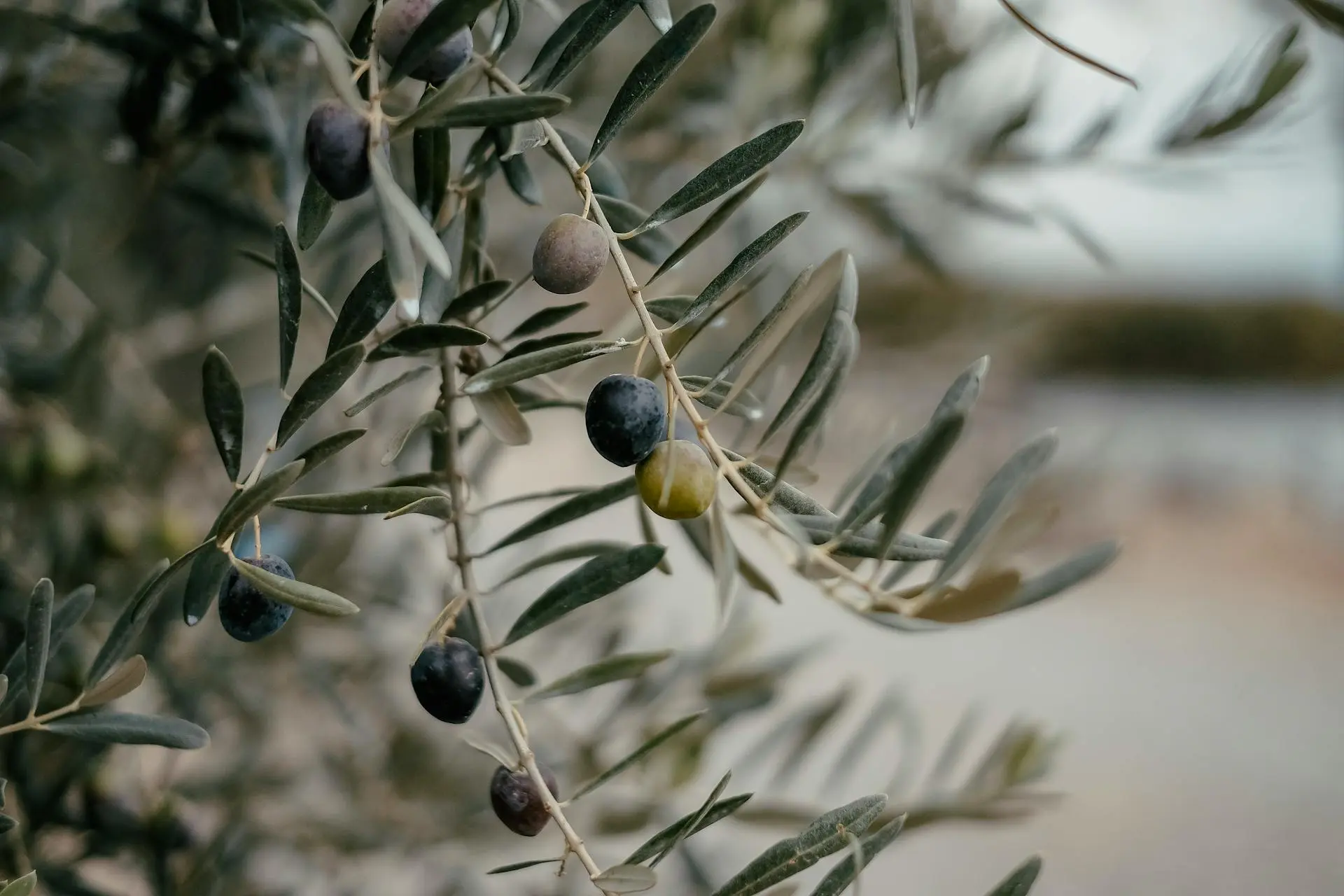
Request a Tree
As a clergy sexual abuse survivor led ministry, Friends for the Journey believes that there is hope for those who have experienced abuse to receive support from our Catholic community, and, in cases of clergy abuse, to receive acknowledgement from the Church that did not protect them. God desires all to live an abundant life in a manner that honors past experiences, and we’d like to join you on your journey toward a more abundant life.
List of Trees
Fruit Trees
Meyer Lemon
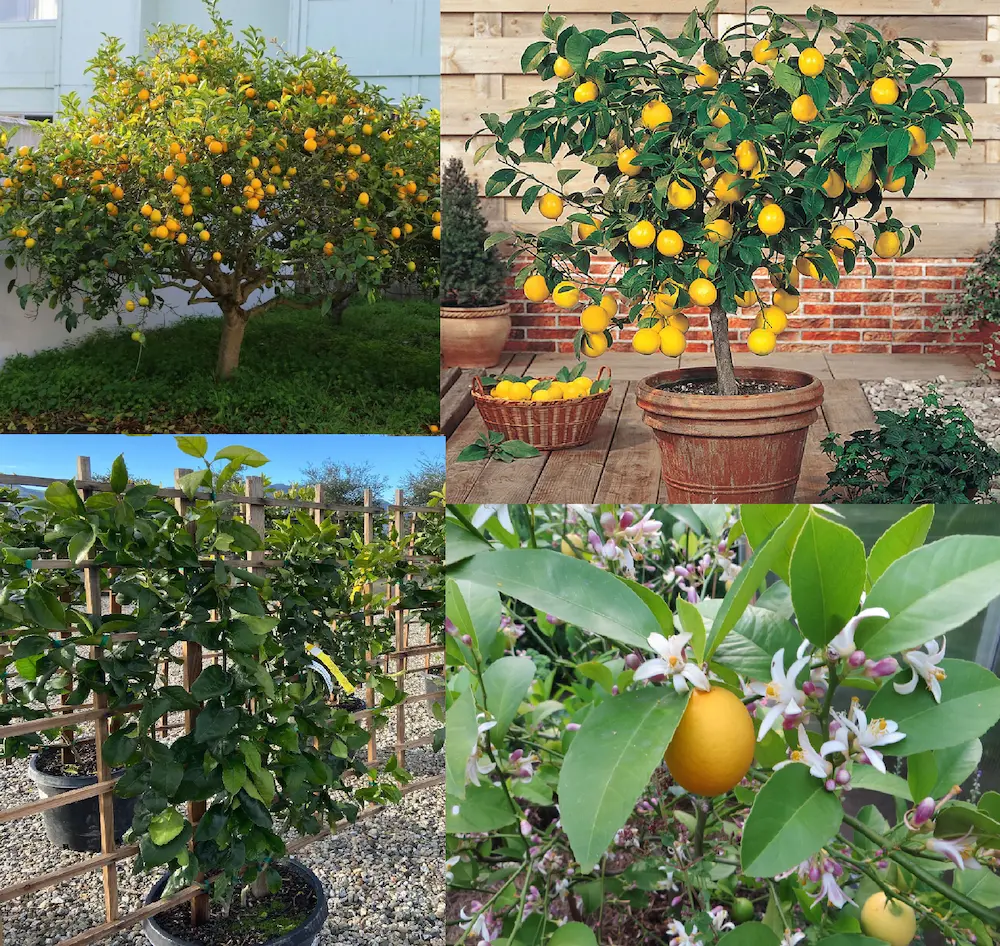
Symbolism
Fidelity of love often associated with Mother Mary.
About the Meyer Lemon
A favorite of home gardeners and chefs, the improved Meyer lemon tree adapts well to growing in containers indoors or outdoors. In temperate climates it may be planted in the ground.
This is the perfect plant to accent your patio – with the bonus of fresh lemons! Enjoy attractive green leaves, beautiful white blossoms, and fragrant flowers, followed by fresh, floral citrus. These lemons are prized for baking delicious desserts and making fantastic cocktails. Homesteaders will enjoy preserving an abundance of fruit. These lovely citrus trees may bloom again while the fruit is still growing, allowing for continuous harvesting!
Meyer lemons are mildly acidic and don’t have the same tang as regular lemons. Instead, they are much sweeter. Meyer lemons are a cross between a regular lemon (Eureka and Lisbon varieties) and a mandarin orange. The skin of the fruit is thin, smooth, and ripens to the color of an egg yolk. The fruit is smaller and more round than regular lemons with dark yellow pulp. It is high in vitamin C, folate, and the antioxidant phytonutrients known as flavanones.
Grown in the ground, the trees can reach up to ten feet tall. In a garden pot, the tree’s height will be reduced by the size of the pot. Pruning helps keep the Meyer lemon tree more manageable with a fuller appearance. This is a self-pollinating variety, so outdoor trees will produce fruit by natural means. Indoor trees can be pollinated by hand using a small paintbrush.
These citrus trees require moist, but not wet, soil, and should be watered deeply, but not frequently. The soil pH should be moderately to slightly acidic. With regular fertilizing, you can have your first harvest within a couple of years! We recommend a high nitrogen fertilizer designed for citrus trees to be applied during the spring and summer months. The improved Meyer lemon tree is more disease resistant than previous varieties.
This citrus plant requires at least six hours of sunlight. In warmer climates, morning sun and afternoon shade are best for growing Meyer lemons. These trees are heat tolerant, but not cold-hardy, so if you live outside of the recommended growing zones, be sure to treat them as houseplants before freezing temperatures arrive by bringing the plants
indoors. The plants begin bearing fruit in one to two years.
*Can be transplanted into a pot rather than in the ground and kept in the yard or patio or indoors.*
Characteristics
Bloom Color: White
Fruit Color: Yellow
Fruit Size: Small – Medium
Pollination: Self-Pollinating
Shade/Sun: Full Sun
Taste: Sweet, Tart
Texture: Firm, Juicy
Years to Bear: 1 – 2
Landscaping
Soil Composition: Loamy
Soil Moisture: Well Drained – Average Moistness
Soil pH Level: 5.5 – 6.5
Mature Size: When your tree matures, it will be approximately 8 – 10′ tall x 3 – 5′ wide.
Recommended Spacing: We recommend spacing these trees 8 – 10′ apart to ensure room for growth.
Mission Olive
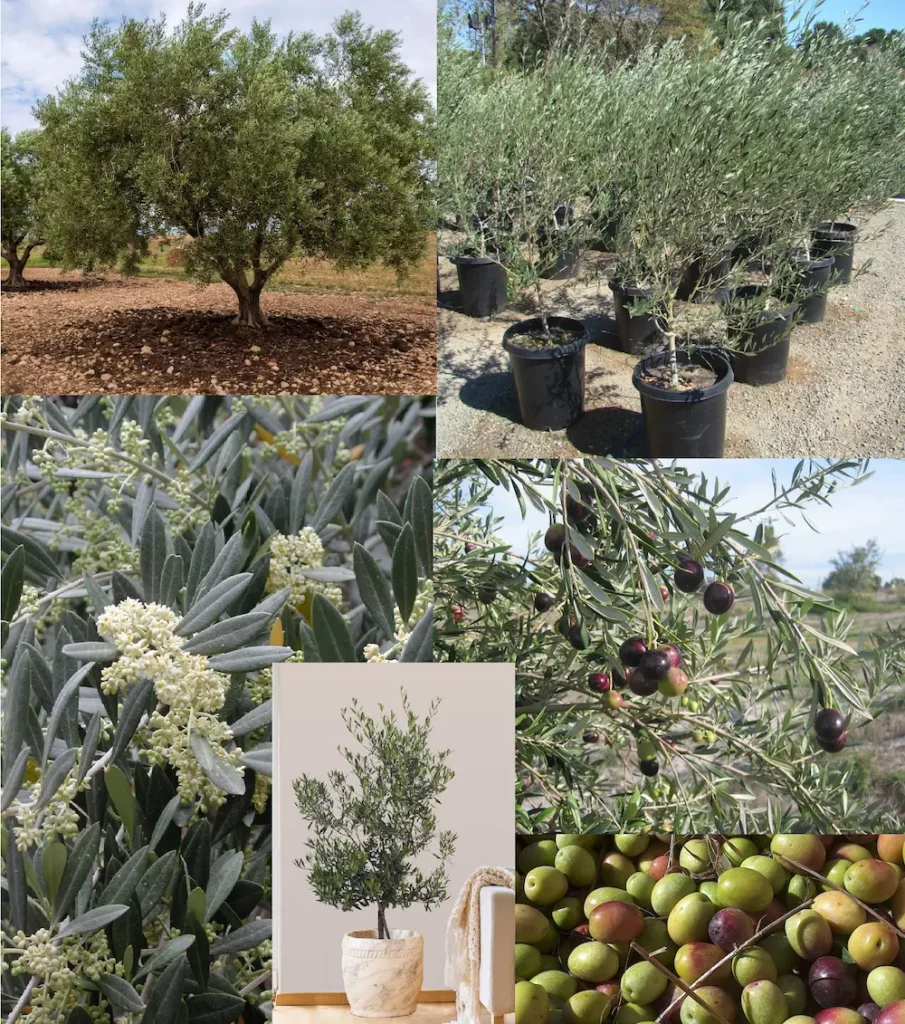
Symbolism
Peace and comfort. Represents the covenant and unity between God and the human race. Jesus prayers under olive trees before offering himself as a living sacrifice for all human kind.
About The Mission Olive
Olea ‘Mission’ Olive Tree, a broadleaf evergreen fruit tree, is not only productive but also extremely attractive, with an elegant, modern aesthetic that is perfect for today’s landscapes or edible gardens. A strong, vigorous tree, it has a smooth trunk in youth that becomes beautifully gnarled with age and bears a rounded canopy of delicate, finely textured leaves with gray-green tops and silvery undersides. In summer, the tree blooms in dainty white flowers, which are fragrant and attract pollinating bees. In fall, it sets green fruits that ripen to purplish black. The olives can be harvested at either the green or black stage. Excellent quality, they have a rich buttery flavor that is perfect for table olives or oil production. The young tree branches also make beautiful displays on their own or lovely additions to floral arrangements.
Olea ‘Mission’ Olive Tree is an excellent accent or specimen but can also be trained as an espalier or grown as a container plant. In the garden, ‘Mission’ reaches 20 to 30 feet tall at full maturity, but it can be pruned to maintain any desired size and shape. In a container, the tree will be much smaller but will still flower and set full-sized fruits. Best harvests occur when 2 or more different varieties are grown together.
‘Mission’ is an Olea europaea variety, commonly called the common olive or European olive. A Mediterranean native, common olive trees perform best in regions with hot, dry summers and mild, wet winters, but they also grow well in coastal regions. And ‘Mission’ is exceptionally cold hardy (to 20°F) for a common olive tree. Easy to grow, the common olive tree grows best in a location with full sun and fertile, moist, well-draining soil. It is drought tolerant once
established.
*Can be transplanted into a pot rather than in the ground and kept in the yard or patio or indoor.*
Plant Description
Fruit: Yes
Bloom Color: White
Fragrant: Yes
Bloom Season: Early Spring
– Late Spring
Foliage Color: Dark Green
Landscaping
Mature Height: 30 Feet
Sun / Shade: Full Sun
Moisture Level: Moist, well-drained
Resistance: Drought Tolerant once established
Special Features: Butterfly Lovers, Edible, Evergreen
Uses: Beds, Containers, Cuisine, Specimen
Santa Rosa Plum
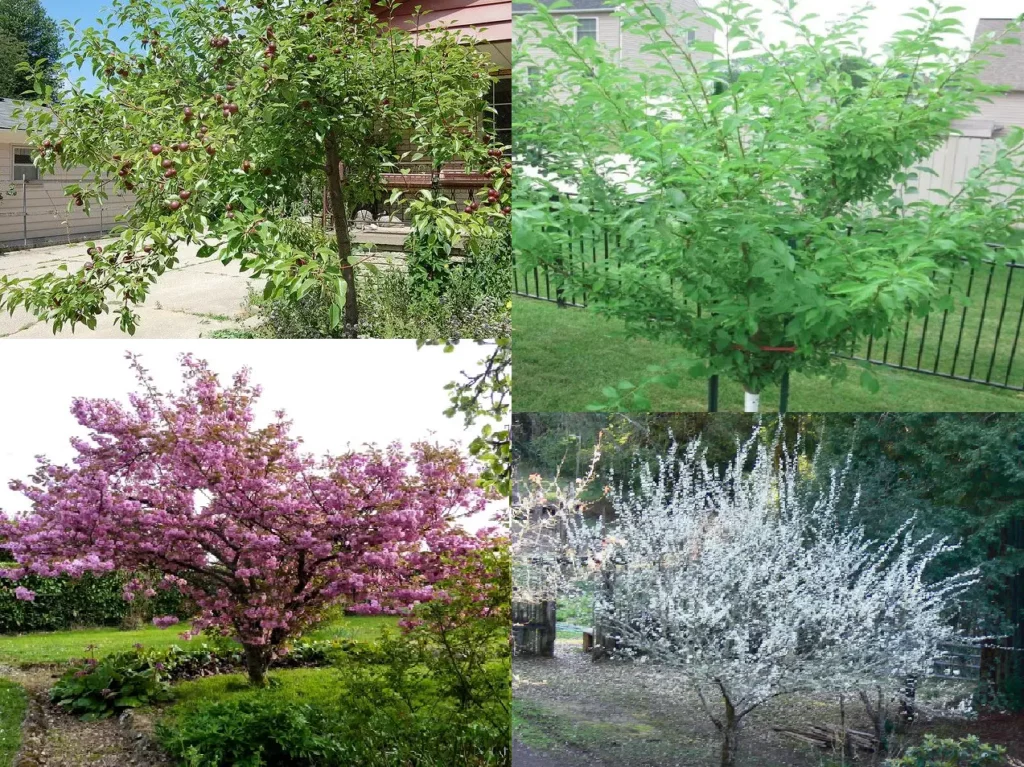
Symbolism
Perseverance and hope. The fruit blooming means winter is ending and the herald of spring. The blossoms start to form on lanky practically bare branches in dead of winter even with a layer of snow on the branches like the Christ child being received in the most humble of settings in His birth.
A favorite of home gardeners and farmers’ markets, the Santa Rosa plum, was introduced in 1906 by famed horticulturalist, Luther Burbank, out of his home in Santa Rosa, California.
It is known for its sweet, slightly tart taste, and deep purple red color. This variety typically takes less years to begin bearing fruit than other plums. Commercial fruit production of the Santa Rosa plum is rare.
This Japanese plum variety makes a stunning ornamental tree with its showy, pinkish white blossoms in the spring.
A single tree can produce an abundance of fruit. Home gardeners and homesteaders will enjoy eating the plums fresh or cooking with them. For preservation, plums can be canned, made into jam, or dehydrated into prunes.
The skin of the plum is thin, and its yellow flesh clings tightly to the pit. Plums are good sources of fiber and high in vitamins A, C, and K. Due to its dark red coloring, the Santa Rosa plum is high in the antioxidants known as anthocyanins.
These fruit trees need full sun and, in the winter, require 500 chill hours.
It is self-pollinating, but cross pollinating with other Japanese varieties will result in greater yield.
*Can be transplanted into a pot rather than in the ground and kept in the yard or patio.*
Characteristics
Bloom Color: White or Pink
Fruit Color: Red
Fruit Size: Large
Pollination: Self-Pollinating
Ripens/Harvest: July
Taste: Sweet
Texture: Firm
Years to Bear: 3 – 6
Landscaping
Shade/Sun: Full Sun
Soil Composition: Loamy
Soil Moisture: Well Drained
Soil pH Level: 6.0 – 7.0
Zone Range: 5 – 9
Mature Size: When your tree matures, it will be approximately 18 – 20′ tall x 18 – 20′ wide.
Recommended Spacing: 18 – 20′ apart to ensure room for growth.
Ornamental Trees
Crepe Myrtle
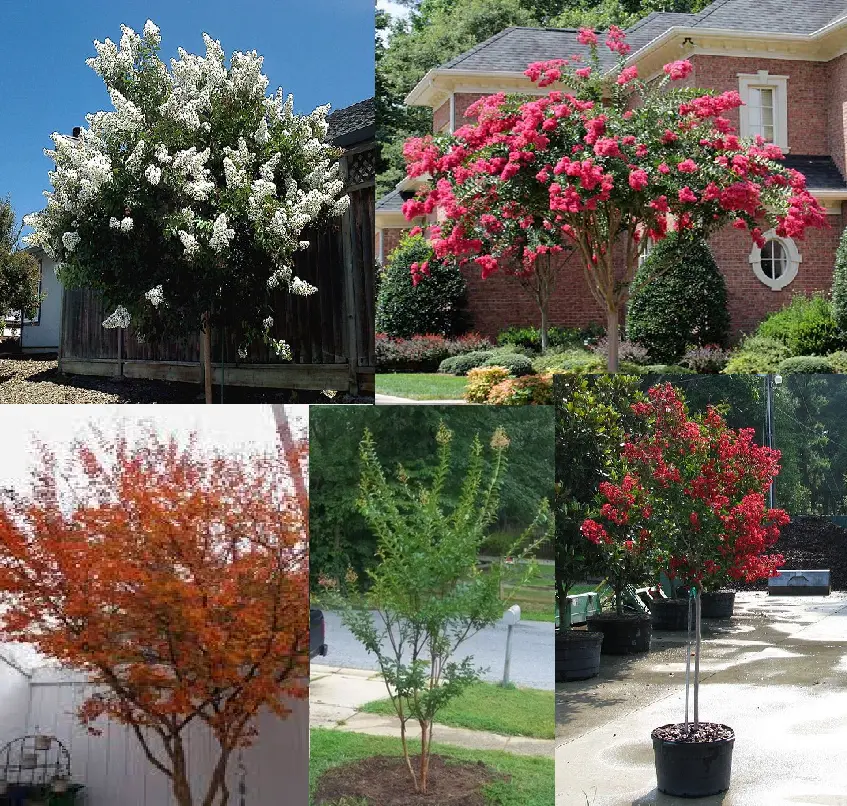
Huge, classic white or red flower clusters adorn this beautifully shaped tree for months. And when the blooming winds down the show doesn’t stop! The lush, green leaves morph into an absolutely stunning display of fiery orange-red in autumn. The smooth cinnamon bark is a delight as it peels in summer revealing a fresh beige bark underneath. It is a beautiful look that gives this tree even more style and flair!
Touted for its pest and disease resistance and it extended bloom time, the Natchez Crape Myrtle is a must-have tree! Add in its drought tolerance and deer resistance and you just cannot pass this tree up! The Natchez is virtually maintenance-free. Just plant this hardy crepe myrtle in full sun and any well-draining soil and you are set! No pruning needed to maintain the stunning shape. Let it grow naturally for a fabulous form.
*Can be transplanted into a pot rather than in the ground and kept in the yard or patio.*
Plant Characteristics
Flower: White or red bloom clusters
Bloom Time: Summer- Autumn
Hardiness: Super Hardy tree
Fall Color: Orange
Size: Mature Height – 20-30 Feet; Mature Width -15-20 Feet
Landscaping
Soil Type: Adaptable
Sunlight: Full, Partial
Drought Tolerance: Good once established
Shade Trees
Native Coast White Oak
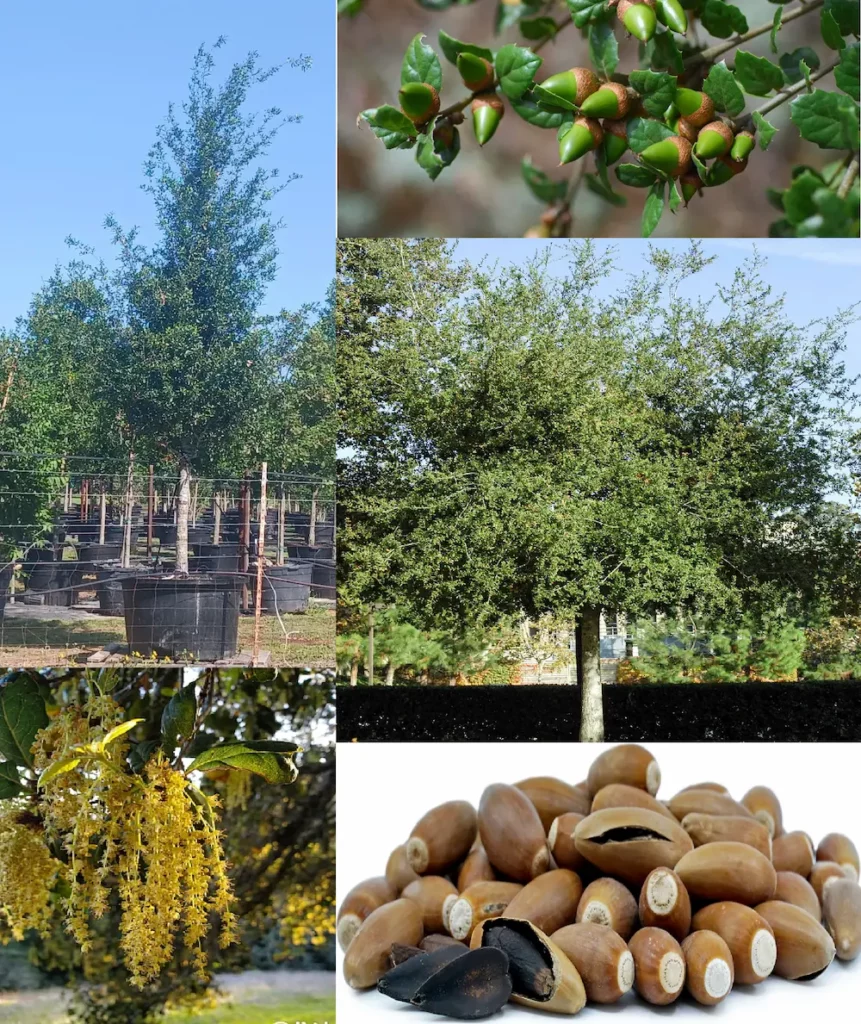
With its rich green foliage and unique branching pattern, the Coast Live Oak is a favored choice for both residential and commercial landscapes. These resilient trees can live for centuries, often surpassing 250 years, and can grow impressively tall, reaching mature heights ranging from 30 to 80 feet.
It is one of the only California native oaks that thrives in coastal environments, it enjoys fog and mild winters. In the first year after planting, water once a week. Then, reduce it to once a month until it reaches about 10 feet tall. After that, avoid watering directly during summer.
Plant Description
Growth Rate: Moderate, Slow
Flower Color: Yellow, Cream, Green
Soil Drainage: Medium
Macadamia Tree
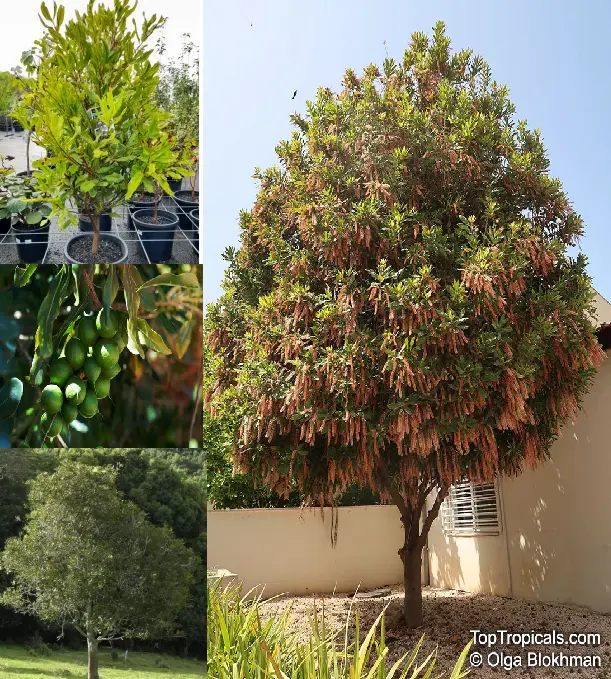
Size: Height- 30 to 50 feet; Spread: 20 to 40 feet
Other: Winter Interest
Tree Request Form
Now that you've been introduced to the various trees we'd like to Plant Hope with you with, please take some time to prayerfully discern your options and then fill in the information below.
